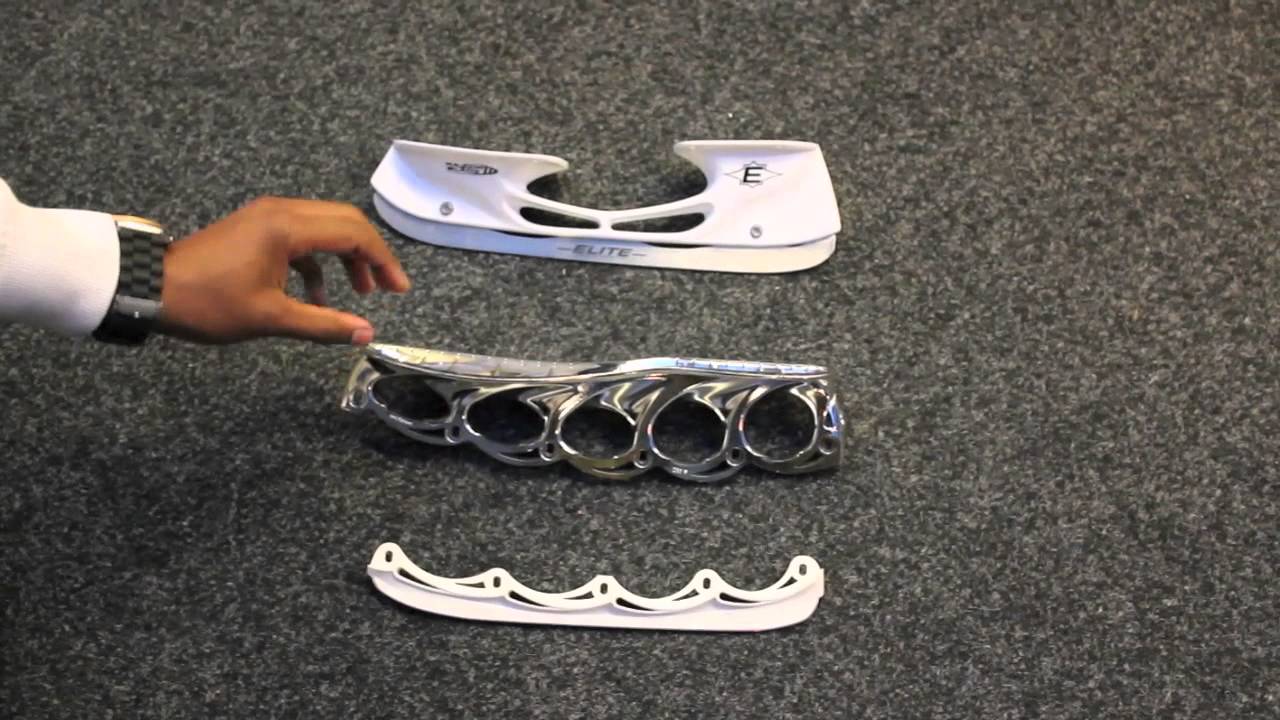The t-blade system describes a blade system for ice skates. It is based on unique technology. The development took place as a result of urgent need to create a blade system which does not require a time consuming and cost-intensive sharpening process and at the same time offers superior gliding characteristics.
The original idea for the t-blades is based on the simple and quick exchange of the runners, as soon as the running surface respectively the edges of the blade are worn (similar to the razor principle & and the replacement of the razor blades). The runners, which are made nearly completely of plastic, are equipped with a thin metal band which represents the actual running surface.
In addition to the runner described above, the t-blade system also consists of the blade holder and a stabilizer which serves to fasten the runner.
Can t-blade runners be sharpened?
No, the t-blade runners cannot be sharpened like traditional ice skate blades. This would result in melting the plastic in the area of the metal strip. Should the runner no longer offer sufficient edge support, it can at any time be replaced simply and quickly with a new runner.
Advantages of t-blades
Each time you get your skate blades (t’blades) replaced, they are exactly the same as the previous set of blades. With T’blades there is no chance of getting a bad sharpen as with conventional hockey skates no sharpen is EXACTLY the same as the previous sharpen.
Due to the very small metal mass (approx. 5.5g), the contact area (gliding area) of the runner can warm up faster and to a higher degree. In connection with the highly polished gliding area, this results in up to 40% better gliding characteristics when compared with traditional ice skate blades. The t in t-blade describes exactly these thermal characteristics which are improved by the plastic in the runner acting as an insulator. In addition, the t-blade blade is the lightest ice skate blade on the market.
Additionally, good manoeuvrability, high cornering speed, and maximum braking deceleration are achieved. The elastic recovery effect of the runner also provides better acceleration behaviour.
By using fibrous plastic (glass or carbon fibber) a maximum rigidity and resistance against fracture of all components in temperatures of up to -25? (-13°F) is achieved.
Disadvantages of t-blades
The concept of t-blades simple has not caught on in North America. Ask yourself this, how many NHL players have you seen using T-blades?
There are a number of reasons for this
Durability – The t-blades are not as long lasting and overall as durable as the standard ice hockey skate, they have so many small and delicate screws that after having used the skates for a short time, become loose and get lots on the ice while skating, parts of the stabilizers get loose and break off. Making the ice skates unsafe! I’ve lost track of how many t-blade users I’ve seen with missing screws in there skates.
- The cost of replacing the t-blade most of the time costs a lot more than a simple blade sharpening
- If your skates suffer from traumawhile about to skate, you have to “order” another set of blades instead of just sharpening them.
- They make a horrible loud sound on the ice. Reason for this being significant is during game of hockey, you can’t quietly get behind an opponent as EVERYONE can hear you on the ice.
- T-blades are getting harder and harder to get hold of as manufactures are doing away with the concept.
I am trying the t-blade system for the first time. Which runner should I use?
T-blade generally sells all there blade systems and ice skates with a factory-installed M-13 runner. This has been established as a standard and offers both, beginners and advanced skaters, good edge support and sufficient gliding characteristics. The majority of their users fares quite well with this arrangement.
For new t-blade users, they recommend more a slightly deeper hollow radius (11,9), in order to get used to the special running characteristics of the t-blade system. Due to the mechanical production of their runners, they have an extremely smooth surface, which offers very good gliding characteristics, but may require initially a brief settling-in phase for some users.
How long does a t-blade runner last?
The t-blade runner, on average, has a 4-5 times longer useful life than a conventional ice skate sharpening. Despite the fact that the metal strip (running strip) is made of especially hard spring steel, an unintentional edge contact (concrete, goal post) will inevitably lead to defects. We, therefore, recommend treating the runner with the same care as any other ice skate blade.
What t-blade runner should i get?
What is the different between the t-blade rockers and hollows?
what does the t-blade rocker and hollow mean and what is the difference ?
all these question are answered with this chart

Sizing Chart for t’blades
Can t-blade runners be sharpened?
- ·No! The t-blade runners cannot be sharpened like traditional ice skate blades. This would result in melting the plastic in the area of the metal strip. Should the runner no longer offer sufficient edge support, it can at any time be replaced simply and quickly with a new runner.
Additionally, the combination of plastic and metal provides huge advantages:
- Due to the very small metal mass (approx. 5.5g), the contact area (gliding area) of the runner can warm up faster and to a higher degree. In connection with the highly polished gliding area, this results in up to 40% better gliding characteristics when compared with traditional ice skate blades. The t in t-blade describes exactly these thermal characteristics which are improved by the plastic in the runner acting as an insulator. In addition, the t-blade blade is the lightest ice skate blade on the market.
- Additionally, good manoeuvrability, high cornering speed, and maximum braking deceleration are achieved. The elastic recovery effect of the runner also provides better acceleration behaviour.
- By using fibrous plastic (glass or carbon fibber) a maximum rigidity and resistance against fracture of all components in temperatures of up to -25?(-13°F) is achieved.
I am trying the t-blade system for the first time. Which runner should I use?
- T-blade generally sell all there blade systems and ice skates with a factory-installed M-13 runner. This has been established as a standard and offers both, beginners and advanced skaters, good edge support and sufficient gliding characteristics. The majority of their users fares quite well with this arrangement.
For new t-blade users, they recommend more a slightly deeper hollow radius (11,9), in order to get used to the special running characteristics of the t-blade system. Due to the mechanical production of their runners, they have an extremely smooth surface, which offers very good gliding characteristics, but may require initially a brief settling-in phase for some users.
How long does a t’blade runner last?
- ·The t’blade runner, on average, has a 4-5 times longer useful life than a conventional ice skate sharpening. Despite the fact that the metal strip (running strip) is made of especially hard spring steel, an unintentional edge contact (concrete, goal post) will inevitably lead to defects. We, therefore, recommend treating the runner with the same care as any other ice skate blade.






